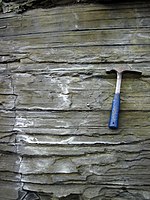
Photo from wikipedia
Abstract The coal and host rocks (mainly oil shale partings) in the Laoheishan basin (NE China) are oil-prone. This study uses petrological, mineralogical and geochemical analyses to determine the reasons… Click to show full abstract
Abstract The coal and host rocks (mainly oil shale partings) in the Laoheishan basin (NE China) are oil-prone. This study uses petrological, mineralogical and geochemical analyses to determine the reasons of high oil yield in the coal, and the origin and modes of occurrence of the minerals and elements in the coal and oil shale partings. The obtained data show that this sub-bituminous B coal has higher oil yield (av. 10%) than oil shale partings (av. 5.7%), consistent with a higher hydrogen content in the coal. This oil-prone coal has potential for comprehensive utilization due to the relatively high gross calorific value (av. 17.23 MJ/kg) in the semi-coke. The maceral composition suggests that the relatively high hydrogen content in the coal is mainly caused by higher resinite content. Palynological analysis of coal and oil shale partings mainly proved the presence of gymnosperms and ferns, revealing that the paleovegetation is dominated by lygodiacean-/osmundacean ground ferns and cupressaceaen/taxodiaceaen canopy trees, these canopy trees would have provided abundant hydrogen rich components (e.g. resin) to the paleomire. All the identified sporopollen suggests a warm-humid subtropical paleoclimate. Minerals in the coal include kaolinite, quartz, illite (and/or illite/smectite), chlorite, feldspar, calcite, and traces of pyrite, rutile and zircon, similar to the oil shale partings. Most of the minerals (quartz, feldspar, clay minerals, rutile and zircon) occur in layers within detrovitrinite and probably are of detrital origin. Pyrite and calcite are of epigenetic origin and probably derived from hydrothermal fluids. Compared with average Chinese coal, the Laoheishan coal is enriched in Zr, Nb, In and Sb. Zirconium and Nb mainly occur in zircon. Indium is both organically and inorganically associated, whereas antimony largely occurs in pyrite. REY (rare earth elements and yttrium) distribution patterns of coals and oil shale partings are dominated by Heavy-REY enrichment, whereas roof and floor samples are Medium-REY enriched. The M-HREY enrichment is probably caused by low-temperature hydrothermal fluids. The sedimentary input is the major controlling factor of geochemical patterns in coal and host rocks. The source rocks are probably felsic-intermediate igneous rocks from the surrounding basement, as indicated by relatively high Al2O3/TiO2 ratios (7–38), cross-plot between Zr/Ti and Nb/Y, negative Eu anomalies (0.28–0.96), the presence of K-feldspar and plagioclase, and lithic fragment types (such as granite and andesite) in the samples. In addition, source rocks of sediments have caused high Zr and Nb concentrations in the coal.
Journal Title: International Journal of Coal Geology
Year Published: 2018
Link to full text (if available)
Share on Social Media: Sign Up to like & get
recommendations!